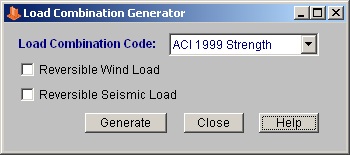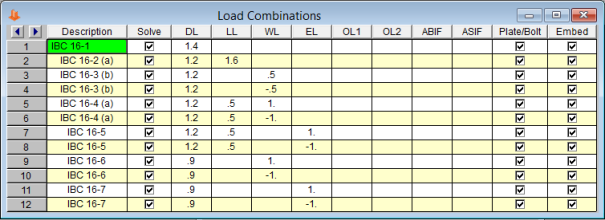
The Load Combinations and Load Combination Generator windows are where you select your design codes and define the appropriate load combinations.
The Load Combination Generator dialog window allows the user to select a code and set parameters for the program to generate load combinations.

Use the dropdown to choose which code should be used to generate the load combinations.
Note:
When these boxes are checked, the program will generate every wind/seismic load combination twice. Once with a positive load factor and once with a negative load factor.
The Load Combinations dialog window defines the load combinations to be included in the solution.

The first column,Description, is strictly for the user's reference. Enter any descriptive label you wish and it will be displayed with the results when the combination is solved.
The Solve column contains checkboxes which allow the user to select which load combinations are included in the solution.
The DL, LL, WL, EL, and OL columns define factors to be used in the load combinations.
The ABIF (Allowable Bearing Increase Factor) is the factor applied to the allowable bearing stress for load combinations. This factor is intended to be used only in older codes which allow this increase, as opposed to the AISC 360 which does not.
The ASIF (Allowable Stress Increase Factor) is the factor applied to the allowable bending stress for load combinations. This value is only used when ASD 9th Edition is the design code. Typically this factor would be used for combinations that contain transient loads like earthquake or wind loads
The Plate/Bolt checkbox allows the user to select which load combinations shall be applied to the design of the baseplate and the anchor bolts.
The Embed checkbox allows the user to select which load combinations shall be applied to the calculation of anchor bolt embed capacity.
When you’ve defined your combinations and you’re ready to have RISABase
perform the calculations, you can use the menu to click Solve, or you can click the solve button  .
.
The following functions are available as keyboard commands or by accessing the righ-click menu:
|
Key |
Function |
|---|---|
| Arrow Keys | Move the active cell on location |
| TAB | Move right one cell |
| ENTER |
Move to the first column of the next line. Adds new line if necessary. |
| PAGE UP | Move the active cell one full page up |
| PAGE DOWN | Move the active cell one full page down |
|
HOME |
Move to the first line of the spreadsheet |
| END | Move to the last line of the spreadsheet |
| F3 | Insert new line below current line |
| F4 | Delete current line |
| F8 | Insert new line below current line and repeart the current values in the new line |